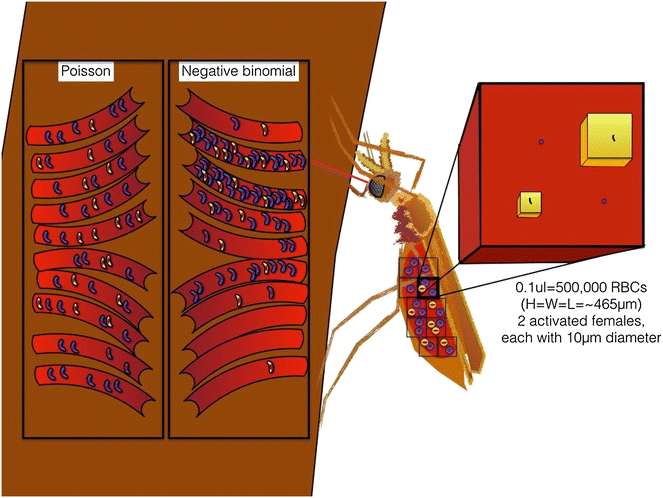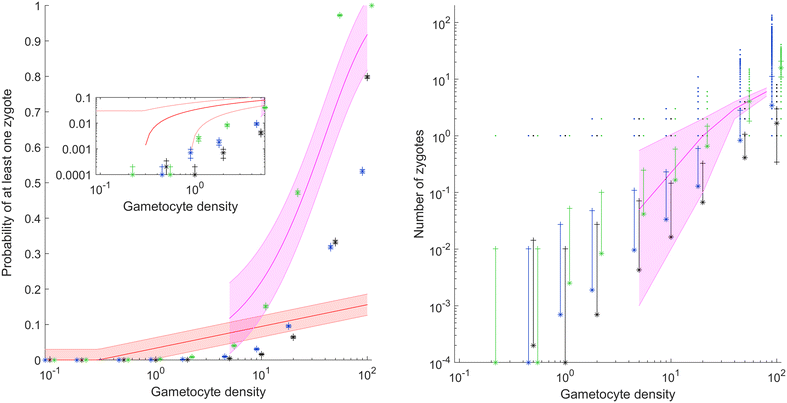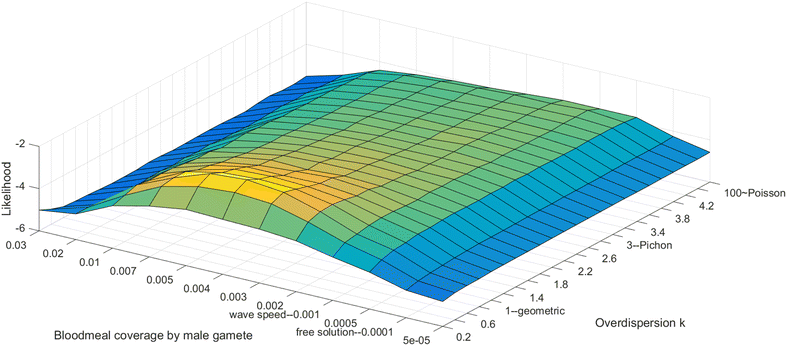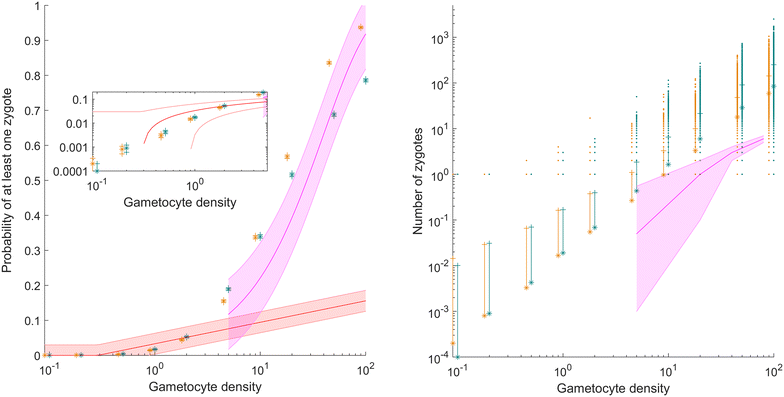A computational lens for sexual-stage transmission, reproduction, fitness and kinetics in Plasmodium falciparum
- PMID: 27653663
- PMCID: PMC5031309
- DOI: 10.1186/s12936-016-1538-5
A computational lens for sexual-stage transmission, reproduction, fitness and kinetics in Plasmodium falciparum
Abstract
Background: The burden of falciparum malaria remains unacceptably high in much of sub-Saharan Africa and massive efforts are underway to eliminate the parasite. While symptoms of malaria are caused by asexual reproduction of the parasite, transmission to new human hosts relies entirely on male and female sexual-stage parasites, known as gametocytes. Successful transmission can be observed at very low gametocyte densities, which raises the question of whether transmission-enhancing mechanisms exist in the human host, the mosquito, or both.
Methods: A new computational model was developed to investigate the probability of fertilization over a range of overdispersion parameters and male gamete exploration rates. Simulations were used to fit a likelihood surface for data on rates of mosquito infection across a wide range of host gametocyte densities.
Results: The best fit simultaneously requires very strong overdispersion and faster gamete exploration than is possible with random swimming in order to explain typical prevalence levels in mosquitoes. Gametocyte overdispersion or clustering in the human host and faster gamete exploration of the mosquito blood meal are highly probably given these results.
Conclusions: Density-dependent gametocyte clustering in the human host, and non-random searching (e.g., chemotaxis) in the mosquito are probable. Future work should aim to discover these mechanisms, as disrupting parasite development in the mosquito will play a critical role in eliminating malaria.
Keywords: Gametocytes; Mathematical model; Plasmodium falciparum.
Figures




Similar articles
-
Recognition of Plasmodium falciparum mature gametocyte-infected erythrocytes by antibodies of semi-immune adults and malaria-exposed children from Gabon.Malar J. 2017 Apr 26;16(1):176. doi: 10.1186/s12936-017-1827-7. Malar J. 2017. PMID: 28446190 Free PMC article.
-
Population biology and antimalarial resistance: The transmission of antimalarial drug resistance in Plasmodium falciparum.Acta Trop. 2005 Jun;94(3):230-40. doi: 10.1016/j.actatropica.2005.04.014. Acta Trop. 2005. PMID: 15878154 Review.
-
Modeling the dynamics of Plasmodium falciparum gametocytes in humans during malaria infection.Elife. 2019 Oct 29;8:e49058. doi: 10.7554/eLife.49058. Elife. 2019. PMID: 31658944 Free PMC article.
-
Host haematological factors influencing the transmission of Plasmodium falciparum gametocytes to Anopheles gambiae s.s. mosquitoes.Trop Med Int Health. 1999 Feb;4(2):131-8. doi: 10.1046/j.1365-3156.1999.00361.x. Trop Med Int Health. 1999. PMID: 10206267
-
Immune Responses to the Sexual Stages of Plasmodium falciparum Parasites.Front Immunol. 2019 Feb 11;10:136. doi: 10.3389/fimmu.2019.00136. eCollection 2019. Front Immunol. 2019. PMID: 30804940 Free PMC article. Review.
Cited by
-
Plasmodium asexual growth and sexual development in the haematopoietic niche of the host.Nat Rev Microbiol. 2020 Mar;18(3):177-189. doi: 10.1038/s41579-019-0306-2. Epub 2020 Jan 9. Nat Rev Microbiol. 2020. PMID: 31919479 Free PMC article. Review.
-
Critical Steps of Plasmodium falciparum Ookinete Maturation.Front Microbiol. 2020 Mar 17;11:269. doi: 10.3389/fmicb.2020.00269. eCollection 2020. Front Microbiol. 2020. PMID: 32256458 Free PMC article.
-
Structure of endogenous Pfs230:Pfs48/45 in complex with potent malaria transmission-blocking antibodies.bioRxiv [Preprint]. 2025 Jun 15:2025.02.14.638310. doi: 10.1101/2025.02.14.638310. bioRxiv. 2025. PMID: 39990443 Free PMC article. Preprint.
-
Single-cell RNA-seq reveals hidden transcriptional variation in malaria parasites.Elife. 2018 Mar 27;7:e33105. doi: 10.7554/eLife.33105. Elife. 2018. PMID: 29580379 Free PMC article.
-
Plasmodium falciparum Gametocyte Density and Infectivity in Peripheral Blood and Skin Tissue of Naturally Infected Parasite Carriers in Burkina Faso.J Infect Dis. 2021 May 28;223(10):1822-1830. doi: 10.1093/infdis/jiz680. J Infect Dis. 2021. PMID: 31875909 Free PMC article.
References
-
- Anderson RM, May RM. Regulation and stability of host-parasite population interactions. J Anim Ecol. 1978;47:219–247. doi: 10.2307/3933. - DOI
Grants and funding
LinkOut - more resources
Full Text Sources
Other Literature Sources

